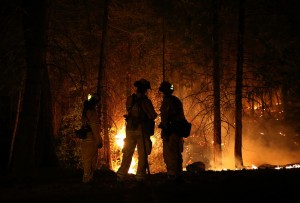
Latest post: Blaze Slows But Remains Extremely Dangerous
Details, as of 10:30 p.m. PDT Friday: The fire that's been burning all week just west of Yosemite took another giant leap in size Friday, with U.S. Forest Service and CalFire reporting the blaze, named the Rim Fire, has now covered more than 125,000 acres (more below on how big that really is). The conflagration is just 5 percent contained, and a force of nearly 2,700 firefighters, backed by big aerial tankers, is struggling to stop the blaze as gusty winds drive it through rugged, hard-to-reach terrain. Fire officials say the blaze threatens 5,500 homes. So far, four homes have burned along with about a dozen other structures.
- Early Friday, the fire crossed the western boundary of Yosemite National Park, burning in a remote area near Lake Eleanor. The blaze remains far from iconic park destinations like Yosemite Valley.
- Later in the day, officials said the fire had spread west toward the Highway 108, the route between the town of Sonora and Sonora Pass, and that aerial tankers were flying missions to try to slow the spread of the blaze in that direction.
- So far, the gated resort town of Pine Mountain Lake (population 2,800) and rural settlement of Buck Meadows (50 people) are the only communities facing a mandatory evacuation. But authorities issued evacuation advisories for several other towns, including Tuolumne City (population 1,800), Groveland (600) and Ponderosa Hills.
- Gov. Jerry Brown declared a state of emergency for San Francisco, which has major water and hydropower resources in the fire area. The declaration makes state funds available to the city to respond to the threat to the facilities and could free federal funding to help offset the city's costs in replacing electrical power it's been unable to generate during the fire. Earlier, Brown declared a state of emergency for Tuolumne County to help local officials with their emergency response.
- Highway 120 west of Yosemite, the main route to the park from the Bay Area, remains closed. Travelers can still get into the park on Highway 140 (via Merced), Highway 41 (via Oakhurst) and on Highway 120 east of the park (via Lee Vining and Tioga Pass).
- San Francisco has shut down two powerhouses in the fire zone and is waiting to get the all-clear from fire officials before sending crews in to inspect them. The facilities are part of the city's Hetch Hetchy water and power system and can generate 160 megawatts of power. The city uses that electricity to run Muni, light City Hall, and for the rest of its municipal needs. For the time being, it's replacing the power with energy "banked" with PG&E and by buying electricity from other providers.
- Hotels and resorts in the area have been shut down, along with several municipal high-country vacation retreats such as San Francisco's Camp Mather. We haven't seen any hard numbers on how many people have actually been evacuated from the area.
- KQED News Associate Berkeleyside reports that UC Berkeley has closed its popular camp, Lair of the Bear. The city of Berkeley's Tuolumne Family Camp, San Jose's city camp and the Jewish Camp Tawonga have also been evacuated.
- Air quality regulators in Reno have issued an alert for unhealthy air for the next several days as smoke from the Rim Fire and a second blaze farther north in the Sierra, the American Fire, is carried to the northeast.
Now, how big is 125,000 acres? Some news organizations, like NPR, have taken to reporting the size of fires in square miles instead of acres, apparently in the belief that listeners and readers can better grasp the magnitude of the events that way. So, 105,000 acres is 196 square miles. Here's still another way to think of the size of this fire, which has grown eightfold in area since early Wednesday:
One hundred ninety-six square miles is:
- About four times the area of San Francisco.
- Roughly equivalent to the combined area of Richmond, El Cerrito, Albany, Berkeley, Emeryville, and Oakland—in other words, nearly everything between the bay shore and crest of the East Bay hills from the Richmond-San Rafael Bridge down to the Oakland Airport.
- All of San Jose's sprawling 180 square miles, with the city of Santa Clara thrown in for good measure.
Here's KPCC's graphic summary of the Rim Fire:
